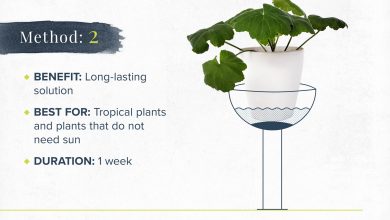Plague Thrips: [Detection, Steps to follow and Products to use]
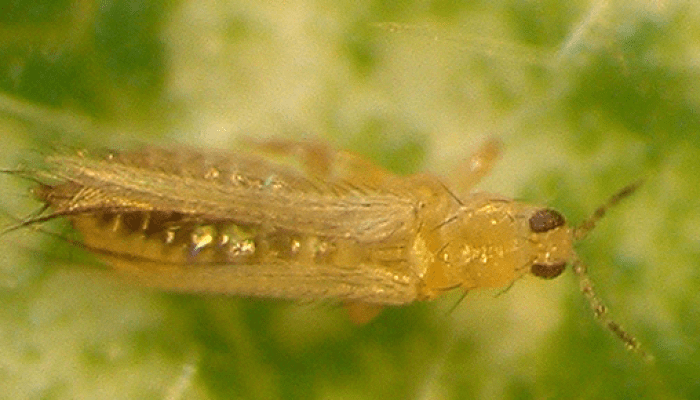
Thrips represent a group of insects whose purpose is to attack certain types of crops.
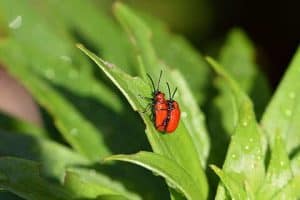 They can become very dangerous, as they carry a virus that causes an incurable disease.
They can become very dangerous, as they carry a virus that causes an incurable disease.
The good news is that there are alternatives to prevent their appearance and eradicate them if they occur.
If you want to know what they are, don’t stop and keep reading.
What are thrips?
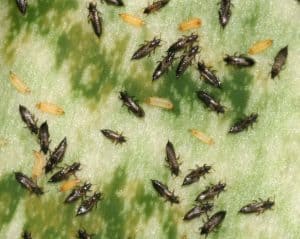 Thrips are insects of varied colors, with an elongated shape and whose saliva exerts considerable damage on the structure of plants.
Thrips are insects of varied colors, with an elongated shape and whose saliva exerts considerable damage on the structure of plants.
They reproduce through eggs that later become larvae. In the adult phase they develop wings with some type of fur.
The colors in which they can be presented are yellow, brown and gray. It is a species that develops in hot environments.
For this reason, summer provides the conditions for its appearance and multiplication. Its reproduction is a simple process that can take a few weeks, from when the egg is generated until the larva hatches.
For this reason, they can spawn a large number of larvae in a short time. Among the plant species that are most affected by the thrips plague are: onions, tomatoes and cucumbers.
Finally, it is necessary to know that thrips are not a single family, but have different types that are attracted to specific types of plants.
How to identify them in our crops?
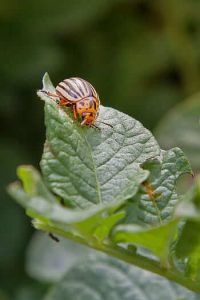 To define how thrips are affecting our crops, it is necessary to refer to their feeding process.The first consumption they make is based on pollen when, in adulthood, they can change from one plant to another.
To define how thrips are affecting our crops, it is necessary to refer to their feeding process.The first consumption they make is based on pollen when, in adulthood, they can change from one plant to another.
But when they are still larvae, their main source of nutrition is in the internal part of the plant ‘s tissues. Through their sucking mouth and saliva, they gain access to the internal liquid and consume it.
This, not surprisingly, causes a weakening of the blade. The problem is that it not only does this function with the leaves, but also with the entire structure of the plant, including the shoots and fruits.
As the internal vegetable content is sucked out, the leaves begin to lose their characteristic green coloration and this becomes a very visible symptom. In the same structure of the discolored leaf, black dots also appear that correspond to the debris of the larva.
Likewise, yellow or white dots may appear that belong to the damage caused to the surface of the plant material in question. If the pest advances much further, it could transmit diseases to the plants, causing them to wither to death.
Above all, the larvae secrete moderately toxic substances when they notice the presence of other thrips. It’s kind of a defense mechanism.
How can we combat thrips?
Check the plant regularly
The task of combating thrips does not involve extensive and very dedicated work, but it will be necessary to carry out a regular review of the structure of the plant. This will allow you to quickly notice if there is any change in the way it looks or if there are insects hanging around it.
Prevent weeds from growing around crops
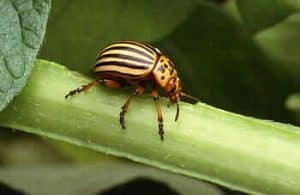 It is also important to have a lot of hygiene around the crops, preventing weeds from growing.
It is also important to have a lot of hygiene around the crops, preventing weeds from growing.
Weeds, in addition to reducing the nutrients that our plants will absorb, are also a refuge center for this pest.
Likewise, it is essential to think that when thrips are offered an environment that is ideal for them, they will end up affecting other crops more quickly.
The recommended care for each species is essential because it will help them to have more resistance to the arrival of any pest.
Take care of irrigation and fertilization times
Therefore, and especially in summer, it is necessary to be careful with the irrigation and fertilization times. All of this will help to potentially eliminate the chances of crops being affected by a pest.
This is important because thrips always tend to attack plants that have some weakness and it is very likely that this part of the care we give it.
use garlic
One last way to prevent and combat its appearance in a homemade way is with the use of garlic. This will be crushed and diluted in water to form a liquid with which we will bathe the entire plant.
Both in this and in other similar processes, it is important not to leave any part untouched with preventive or corrective products.
What products can we use to eliminate thrips?
The products to eliminate thrips are varied and will be chosen based on the particular condition of each crop.
sticky traps
There are sticky traps, such as those used for houseflies, that can be placed around plants to catch them. These are yellow or blue, colors that are attractive to them and to which they end up approaching and ending up stuck.
potassium soap
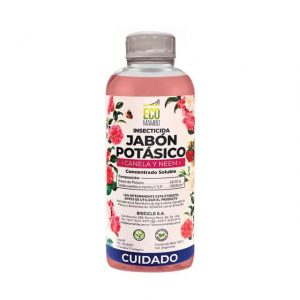 Potassium soap also offers very good results, and being ecological, it does not cause damage to the crop. This also gives security so that we consume what is grown with confidence.
Potassium soap also offers very good results, and being ecological, it does not cause damage to the crop. This also gives security so that we consume what is grown with confidence.
For its application, it will suffice to make a mixture of soap with water and spray it on the entire plant. It is important to attend to all areas, including the underside of the leaves, to avoid leaving any thrips around.
neem oil
To enhance the effect, in case of a very strong plague, neem oil will help a lot and it is also ecological. This oil will be placed after the potassium soap and as it is a powerful insecticide, it will cause a very positive effect.
In fact, it is a very valuable agricultural product to have at home when you have plantations because it is effective against many pests.
Products to clean the molasses resulting from the attack of thrips
Finally, it will be necessary to clean the molasses that has remained as remains of the thrips attack. There are products on the market for this purpose and that have the ingredients ready to work in this regard, even without causing damage to plants.
It is important, before applying any other method that could have a harmful effect, to consult an expert in the field.
Bibliography and references
- Sanchez Gutierrez, Francisco. (1994). Biological control of pests in the greenhouse: red spider,whitefly,aphids, thrips. Mundi Press Books. Madrid Spain.
- Tropical Agronomic Research and Teaching Center. (1979). Integrated pest control in crop production systems for small farmers. CATIE—UC/USAID—OIRSA. Turrialba-Costa Rica.
- Salamanca Bastidas, Jordan; Male Devia, Edgar Herney; Santos Amaya, Oscar. (2010). Breeding and evaluation of the predation capacity of Chrysoperla externa on Neohydatothrips signifer, a thrips pest of passion fruit crops. Corpoica. Agricultural Science and Technology. Cundinamarca-Colombia. Reproduced from: http://www.redalyc.org/articulo.oa?id=449945028004
- Ascencion-Betanzos, G.; Bravo-Mojica, H.; Gonzalez-Hernandez, H.; Johansen-Naime, R.M.; Becerril-Roman, AE (1999). Population fluctuation and thrips damage in avocado cv. Hass. National Autonomous University of Mexico. Texcoco-Mexico. Reproduced from: http://209.143.153.251/WAC4/WAC4_p291.pdf

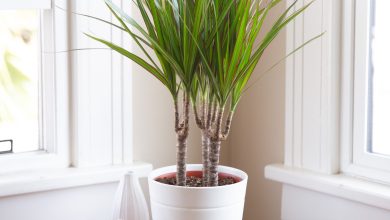
![Photo of Plant a Cherry Tree: The Guide to Do It [Images + Step by step]](https://www.complete-gardening.com/wp-content/uploads/2022/08/plant-a-cherry-tree-the-guide-to-do-it-images-step-by-step-390x220.jpg)
![Photo of Citrus Diseases: [Types, Characteristics and Prevention]](https://www.complete-gardening.com/wp-content/uploads/2022/08/citrus-diseases-types-characteristics-and-prevention-390x220.jpg)
